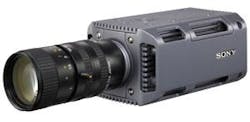Smart cameras shine at The Vision Show
Attend any machine-vision or image-processing-related trade show this year and you will notice a plethora of digital cameras from numerous vendors. Closely examine these products, however, and you will soon discover that most area-array-based cameras use sensors from just a handful of vendors, most notably Micron Technology, Sony, and Kodak.
At The Vision Show, held in June 2008 (Boston, MA, USA), camera vendors from different continents struggled to differentiate their products with digital interfaces ranging from 1394a/b, Gigabit Ethernet, and Camera Link. While some consolidation in the camera market is inevitable, camera vendors are instead choosing different approaches to differentiate their products. Many companies that offer traditional camera products are helping companies build these products.
Fluxdata (Rochester, NY, USA; www.fluxdata.com) showed its latest FD-1665 3-CCD multispectral camera based on the range of FireWire-based cameras from IMI Technology (Encinitas, CA, USA; www.imi-tech.com). “Using off-the-shelf CCD cameras in the design of the FD-1665,” says Pano Spiliotis, chief executive officer of Fluxdata, “allows us to leverage our expertise in beamsplitter technology while offering many cameras with different resolutions and spectral responses.” This permits the camera to be configured with 1384 × 1086, 1624 × 1224, or 2448 × 2048 CCD image sensors with frame rates of 20, 16, and 15 frames/s, respectively. By mixing monochrome and color CCD sensors, the camera can capture three to nine spectral bands.
“In many pharmaceutical applications,” notes Spiliotis, “the spectral bandwidth of each channel can be as narrow as 10 µm.” To image these channels, each individual sensor can be fitted with specialized notch filters from companies such as Semrock (Rochester, NY, USA; www.semrock.com). In this way, narrow multispectral channels in the UV, visible, and near-IR can be imaged by the prism-based camera. Costing approximately $20,000 to $35,000, depending on sensor configuration, the camera uses three independent FireWire outputs to provide independent control of exposure gain and readout.
Multispectral cameras are just one way that vendors such as Fluxdata and JAI (Copenhagen, Denmark; www.jai.com) are differentiating their cameras. Smart-camera vendors are also differentiating their products by offering in-house or third-party machine-vision software with their products. At The Vision Show, for example, Sony Electronics (Park Ridge, NJ, USA; www.sony.com/videocameras) announced it had ported VisionPro software from Cognex (Natick, MA, USA; www.cognex.com) to run on its XCI-V3/XPE smart cameras.
According to Marilyn Matz, Cognex senior vice president, this collaboration will continue in the future, and next month the software will be available running on Sony’s next generation of XCI smart cameras. Although slightly larger than the original XCI-V3/XPE design, the XCI-SX100 and XCI-SX100C cameras are offered in monochrome and color SXGA resolution and feature two USB 2.0 ports, Gigabit Ethernet, and x86 CPUs that support Windows XPe (see Fig. 1).
One of the major elements in the VisionPro toolkit is geometric pattern-matching, a fact not overlooked by Sick (Minneapolis, MN, USA; www.sickusa.com), which also chose the show to debut a vision sensor that uses the technology in its Inspector Vision Sensor, a product clearly designed to challenge Cognex for market share. With a 384 × 384 imager array and ARM-based CPU, the Ethernet-based image sensor features three digital I/O lines and in-built software that performs functions such as edge pixel detection, gray-scale analysis, and geometric pattern-matching (see Fig. 2).
For system developers wishing to test capabilities of this sensor, this software is available from the Sick Web site. “This allows developers to test the software using canned bit-mapped images before purchasing any hardware,” says James Anderson, product manager at Sick.


